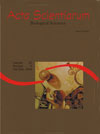Chironomidae larvae (Diptera) from the upper Paraná river floodplain: distribution and composition in different environments and hydrological periods
Abstract
The present study had the aim to identify possible differences in the community structure of Chironomidae larvae in four different environments of the upper Paraná river floodplain with different characteristics and to analyze the influence of abiotic factors and variations in the hydrometric level of the community. Samplings were carried out in March and September, 2003. Four samplings were taken from each of the 12 collecting points: three for biological analysis and one for sediment analysis. Biological contents were washed with the aid of a system with 2.0; 1.0 and 0.2 mm sieves. Chironomidae larvae were identified to the genus level. A total of 1478 Chironomidae larvae were observed, from 19 genera. Polypedilum, Tanytarsus and Chironomus were registered in all environments. The highest values of density and diversity of Chironomidae were registered in low water periods, specially in lentic environments. The variation of density, dominance and diversity of Chironomidae between the two periods was influenced mainly by the hydrological cycle and by the dissolved oxygen, while the spatial variation was associated with the type of sediment, organic matter percentage and the presence or absence of aquatic macrophytes.Downloads
Download data is not yet available.
Published
2007-11-16
How to Cite
Rosin, G. C., & Takeda, A. M. (2007). Chironomidae larvae (Diptera) from the upper Paraná river floodplain: distribution and composition in different environments and hydrological periods. Acta Scientiarum. Biological Sciences, 29(1), 57-63. https://doi.org/10.4025/actascibiolsci.v29i1.127
Issue
Section
Ecology and Limnology
DECLARATION OF ORIGINALITY AND COPYRIGHTS
I Declare that current article is original and has not been submitted for publication, in part or in whole, to any other national or international journal.
The copyrights belong exclusively to the authors. Published content is licensed under Creative Commons Attribution 4.0 (CC BY 4.0) guidelines, which allows sharing (copy and distribution of the material in any medium or format) and adaptation (remix, transform, and build upon the material) for any purpose, even commercially, under the terms of attribution.
Read this link for further information on how to use CC BY 4.0 properly.
0.6
2019CiteScore
31st percentile
Powered by 

0.6
2019CiteScore
31st percentile
Powered by 











1.png)




3.png)













